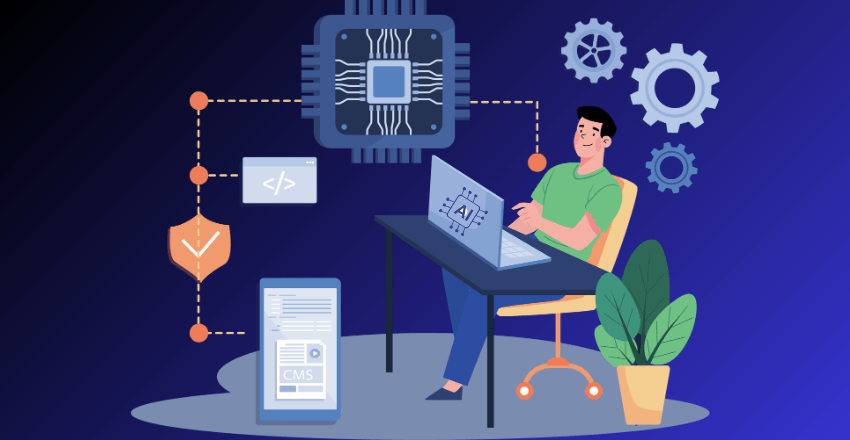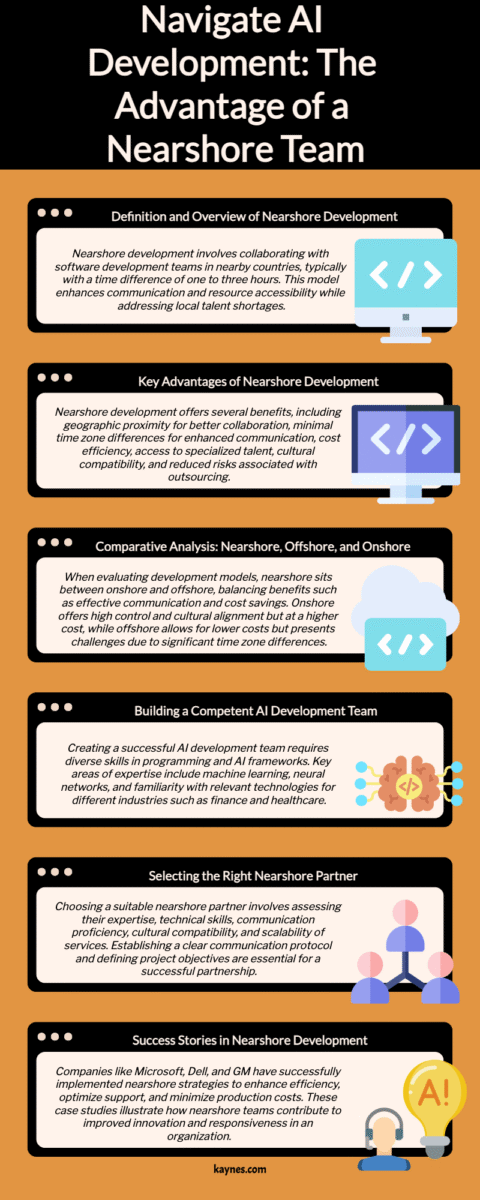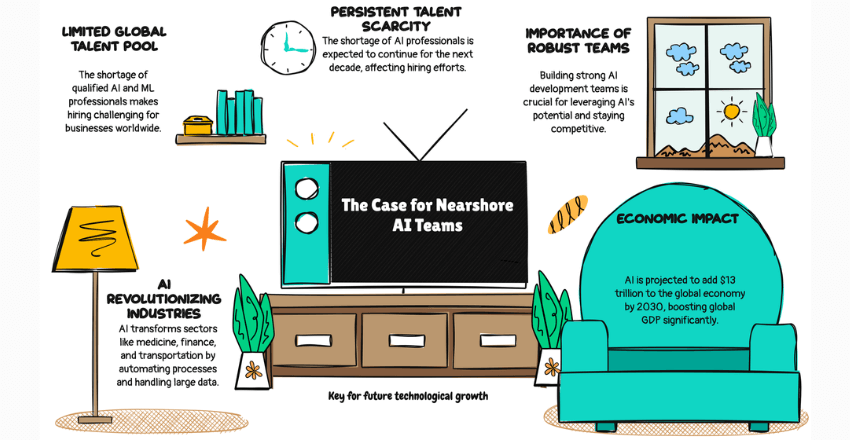
Navigate AI Development: The Advantage of a Nearshore Team
Discover the benefits of a nearshore AI development team to boost your projects with efficiency and expertise.
Thank you for reading this post, don't forget to subscribe!Nearshore Development
In the competitive space of AI and software development, choosing the right cooperation model is crucial. Nearshore development presents an optimal solution, creating a balance between cost efficiency and effective communication.

Nearshore Development Explained
Nearshore software development is a strategic partnership where your company collaborates with an organization or team of software engineers from nearby countries. Typically, these countries are within a one to three-hour time difference. This model is designed to address talent shortages in your own country while maintaining high-quality work.
| Development Model | Definition | Time Zone Difference | Key Benefits |
|---|---|---|---|
| Onshore | Same-country collaboration | None | Easy communication, cultural alignment |
| Nearshore | Collaboration with nearby countries | 1-3 hours | Cost-effective, high communication levels |
| Offshore | Collaboration with distant countries | 5+ hours | Significant cost savings, diverse talent |
Nearshoring sits comfortably between onshore and offshore models, offering a blend of proximity and cost efficiency. It is a popular choice for businesses seeking dedicated AI development teams without the high costs associated with onshore development.
Advantages of Nearshore Development
- Geographic Proximity: Nearshoring provides the advantage of close physical distance. This reduces cultural differences and facilitates easier travel for onsite visits, fostering better collaboration. Unlike offshore teams, you can arrange face-to-face meetings without extensive travel.
- Enhanced Communication: The minimal time zone differences ensure overlapping working hours. This facilitates real-time communication with your nearshore AI development team, leading to quicker decision-making and problem-solving. For more on effective collaboration, visit our page on nearshore ai development services.
- Cost Efficiency: Nearshore development typically offers competitive pricing without compromising quality. While the costs may vary based on several factors such as technology stack, project complexity, and expertise required, the overall cost savings are substantial compared to onshore options.
- Talent Availability: Partnering with a nearshore team opens access to a broader talent pool with specialized skills in AI and machine learning. This helps you overcome local talent shortages and ensures that your projects are handled by experienced professionals. Learn more about tailored solutions on nearshore machine learning solutions.
- Cultural Compatibility: Working with professionals from neighboring countries often reduces cultural and language barriers, leading to smoother collaboration. This cultural alignment can play a critical role in the success of your AI development initiatives.
- Risk Mitigation: By choosing a reliable and experienced nearshore partner, you can mitigate potential risks associated with software outsourcing. These partners bring technical expertise and a deep understanding of effective collaboration, communication, and problem-solving across borders, ensuring successful project outcomes. Tips on choosing the right partner can be found in our guide on nearshore artificial intelligence outsourcing.
Embracing nearshore development for your AI projects offers a combination of proximity, enhanced communication, cost savings, and access to superior talent. This balanced approach can help your business stay competitive and innovate efficiently in the ever-evolving tech landscape.
Nearshore vs. Offshore vs. Onshore
For business owners, CTOs, and tech decision-makers, choosing the right development model is crucial, especially when it comes to building a nearshore AI development team. Here, we’ll compare nearshore, offshore, and onshore development models to help you make an informed decision.
Comparing Development Models
Understanding the key differences between nearshore, offshore, and onshore development can help you choose the best approach for your AI development needs.
| Model | Description | Pros | Cons |
|---|---|---|---|
| Onshore | Development done within the same country | High control, same time zone, cultural alignment | High costs, limited talent pool |
| Offshore | Development done in distant countries | Lower costs, access to a large talent pool | Significant time zone differences, cultural and language barriers |
| Nearshore | Development done in neighboring or nearby countries | Competitive pricing, similar time zones, cultural alignment, easier onsite visits | May still involve some travel costs, potential for varied quality |
The nearshore model, sitting between offshore and onshore, seeks to balance cost savings with improved communication and collaboration.
Nearshore as the Optimal Choice
Choosing a nearshore AI development team can be seen as a win-win situation, offering the best of both worlds:
- Geographical Proximity: With similar or same time zones, real-time collaboration becomes seamless, improving efficiency and reducing delays.
- Cultural Alignment: Working with teams from neighboring countries often means fewer language barriers and more cultural similarities, easing communication.
- Cost Efficiency: While not as low as offshore options, nearshoring still offers significant cost savings compared to onshore development.
- Talent Access: Nearshore development taps into growing tech markets, especially in regions like Latin America. For instance, Costa Rica’s tech sector is projected to grow significantly, providing access to increasing tech talent.
- Flexibility for Onsite Visits: Traveling to nearshore locations is generally easier and less costly, enabling more frequent and effective onsite visits if needed.
These benefits make nearshore development an attractive option for companies looking to build strong nearshore AI development services. With the right partner, you can achieve high-quality, cost-effective results while maintaining alignment and efficient communication. For more insights, check out our guide on nearshore machine learning solutions.
The Case for Nearshore AI Teams

Importance of AI Development
Artificial Intelligence (AI) development is becoming a cornerstone for modern businesses. Companies are discovering the increasing power of AI, making hiring AI developers crucial for success. From automating processes to processing large-scale data, AI is revolutionizing industries such as medicine, finance, and transportation.
The global talent pool for AI and Machine Learning (ML) professionals is extremely limited, leading to a shortage that’s expected to persist over the next decade. This scarcity makes it challenging for many hiring and recruiting teams to find qualified AI developers. As a result, understanding the importance of building a robust AI development team is essential.
AI-centric development is becoming a key focus for industries worldwide, empowering companies to create the next generation of technology. It’s predicted that AI will contribute $13 trillion to the global economy by 2030, translating to a year-over-year increase of 1.2% of the entire globe’s GDP. This makes investing in a strong AI development team not just beneficial, but imperative for future growth.
Explore our services in nearshore AI software development.
Building a Strong AI Development Team
Creating a strong AI development team involves several crucial elements. The team must possess a diverse set of skills and expertise to tackle the complex challenges presented by AI technology. Here’s a look at what constitutes a successful AI development team:
- AI Developer Skills: Proficiency in programming languages such as Python, R, and Java is essential. Developers should also have experience with AI frameworks and libraries like TensorFlow, PyTorch, and Keras.
- Expertise in AI Tech Stack: A thorough understanding of the AI tech stack is necessary, including knowledge of neural networks, natural language processing (NLP), and computer vision. Familiarity with cloud platforms like AWS, Google Cloud, and Azure is also beneficial.
- Knowledge in AI and ML: Developers should have a deep understanding of Artificial Intelligence and Machine Learning concepts, including supervised and unsupervised learning, reinforcement learning, and statistical modeling.
- AI Technologies Relevant to Your Business: Depending on your industry, the team should be familiar with AI technologies that are particularly relevant. For example, in finance, AI applications might include fraud detection and algorithmic trading; in healthcare, they could involve diagnostic analysis and personalized medicine.
| Element | Description |
|---|---|
| AI Developer Skills | Proficiency in programming languages (Python, R, Java), AI frameworks (TensorFlow, PyTorch) |
| AI Tech Stack | Neural networks, NLP, computer vision, cloud platforms (AWS, Google Cloud) |
| Knowledge in AI and ML | Supervised/unsupervised learning, reinforcement learning, statistical modeling |
| Business-Relevant AI Technologies | Fraud detection, algorithmic trading (finance); diagnostic analysis, personalized medicine (healthcare) |
By building a team with these core elements, your organization can navigate the complex landscape of AI development effectively. Nearshore outsourcing offers a solution to the talent scarcity issue, providing access to a broader pool of skilled professionals without the logistical challenges associated with offshore or onshore models.
[Learn more about our nearshore AI development services.]Nearshore AI development teams provide a strategic advantage, offering proximity in time zones and cultural similarities that facilitate seamless collaboration. For businesses looking to harness the power of AI, partnering with a nearshore team can be a game-changing decision.
Discover our nearshore machine learning solutions and nearshore artificial intelligence outsourcing options.
Engaging a nearshore AI development team helps to overcome the challenges posed by the global talent shortage while ensuring the quality and efficiency needed for innovation.
Selecting a Nearshore Partner

Choosing the right nearshore partner for your AI development needs is crucial for the success of your projects. This section outlines the essential criteria to consider and how to ensure your partnership thrives.
Criteria for Choosing
When selecting a nearshore AI development team, several factors need to be taken into account. Here are some criteria to guide your decision-making process:
- Expertise and Experience: Look for a team with a strong portfolio in AI and relevant technologies. The team should have a proven track record in problem-solving and delivering complex projects efficiently.
- Technical Skills: Ensure the team possesses a deep understanding of AI, machine learning, and related disciplines. Verify their proficiency in popular AI frameworks and tools.
- Communication and English Proficiency: Effective communication is vital. Choose a partner with strong English skills and a clear communication protocol.
- Time Zone Proximity: A nearshore team should offer the advantage of similar working hours, therefore aligning your team’s schedule with theirs.
- Cultural Compatibility: Shared cultural values and work ethics can significantly enhance collaboration. Evaluate their work culture to ensure it aligns with your company’s values.
- Scalability and Flexibility: The ability to scale your team as projects grow or shrink is key. Make sure the partner offers flexible contract terms.
Here is a summary table of key criteria to consider:
| Criteria | Importance |
|---|---|
| Expertise and Experience | High |
| Technical Skills | High |
| Communication and English Proficiency | Medium |
| Time Zone Proximity | High |
| Cultural Compatibility | Medium |
| Scalability and Flexibility | High |
For more insights into these factors, see our article on nearshore ai development services.
Ensuring Success Through Partnerships
Once you’ve selected your nearshore AI development team, ensuring success requires a strategic approach. Here are steps to foster a successful collaboration:
- Define Clear Objectives: Clearly outline your project goals, timelines, and expectations. This sets the stage for aligned efforts.
- Establish Communication Protocols: Regular check-ins, progress reports, and an open line of communication ensure transparency and swift issue resolution.
- Utilize Collaborative Tools: Implement tools like Slack, Trello, or Jira for efficient project management and communication.
- Invest in Relationship Building: Foster a strong relationship with your nearshore team through mutual trust and respect. Consider occasional in-person visits if feasible.
- Monitor Performance and Provide Feedback: Regularly evaluate the team’s performance against set benchmarks and provide constructive feedback.
- Focus on Long-term Partnership: Strive for a long-term collaboration that goes beyond individual projects. This builds deeper understanding and better results over time.
For more details on how to effectively manage your nearshore partnership, check out our guide on nearshore artificial intelligence outsourcing.
By carefully selecting your nearshore partner and fostering a strong working relationship, you can maximize the benefits of nearshore AI development and achieve your business objectives effectively.
Nearshore Development Success Stories
The advantages of nearshore development, highlighted by industry leaders, underscore why it has become an optimal choice for tech giants. Below are some notable examples that demonstrate the impact of nearshore AI development teams.
Industry Leaders Embrace Nearshoring
Several prominent companies have successfully adopted nearshoring strategies to enhance their operations and innovate faster.
Microsoft
Microsoft has recognized the potential of nearshoring in Latin America, especially in countries like Mexico and Brazil. By collaborating with local tech firms and talent, Microsoft accelerates its software development cycles, enhances customer support, and deploys cloud solutions more efficiently. Being close to emerging markets also allows them to innovate swiftly and stay ahead of their competitors.
Dell
Dell’s nearshoring to Brazil has enabled them to better cater to the Latin American market. This proximity allows Dell to offer superior customer support, faster service, and localized products, while also saving on shipping costs. Additionally, this move helps in reducing their carbon footprint, making it an environmentally conscious decision.
General Motors (GM)
GM has strategically established significant manufacturing operations in Mexico. This nearshoring initiative has led to reduced production costs and improved time-to-market for the North American region. By being closer to their market, GM can respond more effectively to demand fluctuations, ensuring they remain competitive.
Whirlpool
Whirlpool has successfully implemented nearshoring by moving production to Mexico. This strategic decision has helped them reduce manufacturing costs, optimize their supply chain, and ensure quicker delivery of products to the North American market. The result is a more efficient operation with improved responsiveness to customer needs.
Impact on Global Tech Markets
The integration of nearshore AI development teams has had a profound impact on global tech markets. The following table illustrates some key benefits these industry leaders have experienced through nearshoring:
| Company | Benefit | Impact |
|---|---|---|
| Microsoft | Accelerated development cycles | Faster innovation and deployment |
| Dell | Improved customer support and service | Enhanced market responsiveness |
| GM | Reduced production costs | Improved time-to-market |
| Whirlpool | Optimized supply chain | Quicker product delivery |
These success stories underscore the numerous advantages of adopting a nearshore model. By leveraging nearshore AI software development and partnering with talent from neighboring regions, companies can drive innovation, improve efficiency, and maintain a competitive edge. For more insights on how nearshoring can benefit your business, explore our dedicated sections on nearshore AI development services, nearshore machine learning solutions, and nearshore artificial intelligence outsourcing.
Top Nearshore Development Companies
When considering a nearshore AI development team, it’s essential to choose a partner with a proven track record and the right expertise. Below are some of the top players in the field and the services they offer.
Leading Players in Nearshore Development
Kaynes.com: Tailored Software Development Solutions
Kaynes.com specializes in providing tailored software development solutions, meticulously selecting a team of developers, testers, designers, and infrastructure engineers to meet the unique demands of startups.
Key Advantages:
- Access to Elite Talent: Gain entry to the top 1% of tech talent.
- Effective Communication: Nearshore team works within your time zone.
- Speedy Onboarding: Rapid team assembly and integration.
- Cultural Compatibility: Developers assessed for technical and soft skills.
Why Nearshore with Us?:
- Scalable Solutions
- Flexible Management Options
- Efficient Process
Dualboot Partners
Located in Charlotte, NC, Dualboot Partners specializes in various aspects of software development with a focus on business growth. They have a dedicated development team in Uruguay, making them a solid option for nearshoring needs.
- Location: Charlotte, NC, USA (with a development team in Uruguay)
- Team Size: 250 – 999
- Customer Rating: 4.9 stars (33 reviews on Clutch)
Sigma Software Group
With a broad geographical presence, Sigma Software Group operates in multiple countries and has a significant focus on custom software solutions and IT consulting.
- Location: New York, NY, USA (development team in Ukraine)
- Team Size: 2,000
- Customer Rating: 4.9 stars (32 reviews on Clutch)
Mobcoder
Seattle-based Mobcoder combines USA-based project management with a development team in India to deliver top-notch AI and web application solutions.
- Location: Seattle, WA, USA (development team in India)
- Team Size: 50 – 249
- Customer Rating: 4.9 stars (30 reviews on Clutch)
- Hourly Rate: $50 – $99/hr
Services Offered by Top Companies
These top nearshore development companies offer a range of services tailored to address the complex needs of AI projects:
| Company | AI Services Offered | Custom Software Development | UX/UI Design | Web Development | QA & Testing | IT Consulting & Digital Transformation |
|---|---|---|---|---|---|---|
| Kaynes | Yes (AI, ML, and Data Science) | Yes | Yes | Yes | Yes | Yes |
| Dualboot Partners | Yes (AI-Driven Product Strategy) | Yes | Yes | Yes | No | Yes |
| Sigma Software Group | Yes (AI & Machine Learning Solutions, Data Analytics) | Yes | No | Yes | Yes | Yes |
| Mobcoder | Yes (AI, ML, and BI) | Yes | Yes | Yes | Yes | No |
By understanding the services offered, you can better align your project needs with the right partner. For more information on nearshore AI development services, visit our detailed guides.
To learn more about the impact of nearshore partnerships and choosing the right partner for your needs, explore our articles on nearshore machine learning solutions and nearshore artificial intelligence outsourcing.


